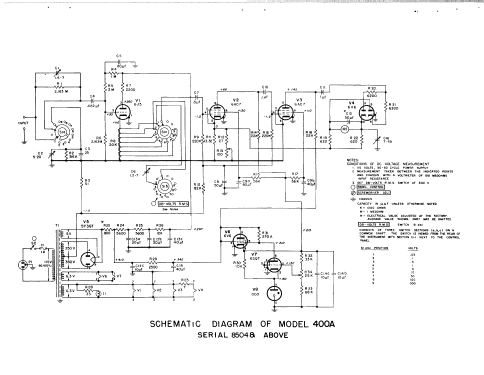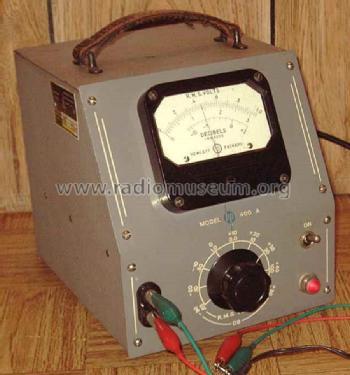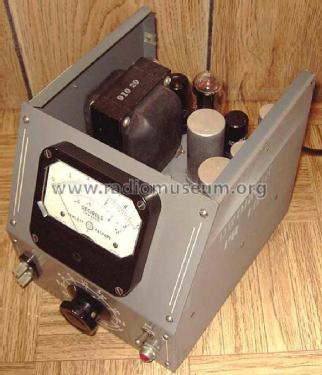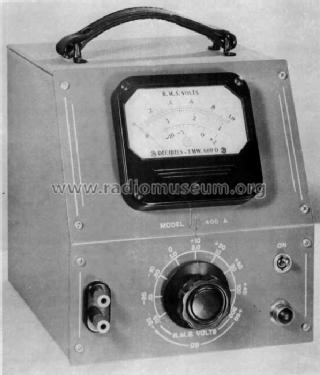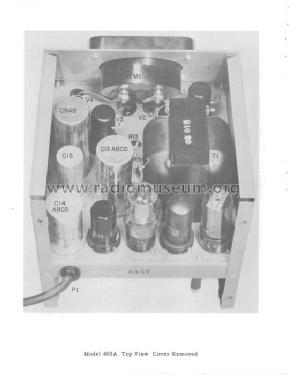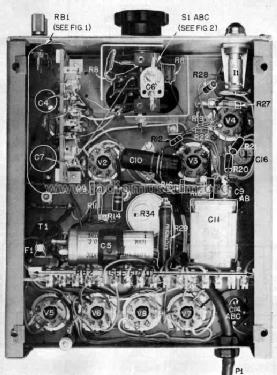Voltmeter 400A
Hewlett-Packard, (HP); Palo Alto, CA
- Land
- USA
- Hersteller / Marke
- Hewlett-Packard, (HP); Palo Alto, CA
- Jahr
- 1942–1948
- Kategorie
- Service- oder Labor-Ausrüstung
- Radiomuseum.org ID
- 82824
Klicken Sie auf den Schaltplanausschnitt, um diesen kostenlos als Dokument anzufordern.
- Anzahl Röhren
- 7
- Hauptprinzip
- Spezielle Schaltung? Bitte bei Bemerkung nachtragen.
- Betriebsart / Volt
- Wechselstromspeisung / 115 Volt
- Lautsprecher
- - - Kein Ausgang für Schallwiedergabe.
- Material
- Metallausführung
- von Radiomuseum.org
- Modell: Voltmeter 400A - Hewlett-Packard, HP; Palo Alto
- Form
- Tischgerät, Schräg-Pult-Form.
- Abmessungen (BHT)
- 7.56 x 10.2 x 9.5 inch / 192 x 259 x 241 mm
- Bemerkung
- Info on HPs page:
At the time of their introduction, HP voltmeters offered unprecedented reliability for their price.
The first voltmeter, the 400A, was introduced early in 1942 after a design by Dave Packard in 1941. It was manufactured until 1958. Notable for stability (it was one of the earliest vacuum tube voltmeters to need no initial adjustment for zero and none for drift) and for wide high input impedance over 1 MHz bandwidth, the 400A became an industry classic. A key to achieving its performance was application of negative feedback in amounts then unheard of.
The HP Model 400A vacuum tube voltmeter, a recent development of HP laboratories, possesses all the important desirable features. It is one of the best available for measurements below 1 megacycle. It is extremely easy to operate, yet its accuracy is unexcelled and it has extreme sensitivity over a wide frequency range. One of the outstanding features of the HP 400A is that the voltage indication is proportional to the average value of the full wave. This is a feature not found in most electronic meters on the market today.
- Nettogewicht
- 7.5 kg / 16 lb 8.3 oz (16.52 lb)
- Originalpreis
- 185.00 $
- Datenherkunft
- - - Manufacturers Literature
- Autor
- Modellseite von Ernst Erb angelegt. Siehe bei "Änderungsvorschlag" für weitere Mitarbeit.
- Weitere Modelle
-
Hier finden Sie 399 Modelle, davon 367 mit Bildern und 139 mit Schaltbildern.
Alle gelisteten Radios usw. von Hewlett-Packard, (HP); Palo Alto, CA
Sammlungen
Das Modell Voltmeter befindet sich in den Sammlungen folgender Mitglieder.
Forumsbeiträge zum Modell: Hewlett-Packard, HP;: Voltmeter 400A
Threads: 1 | Posts: 1
The HP 400A Vacuum Tube Voltmeter
"From HP Catalog 18A" Laboratory
Instruments", Copyrighted 1945."

ADVANTAGES:
Wide voltage range
High sensitivity
Hairline accuracy
Time saving stability
High input impedance
Large overvoltage capacity
Waveform errors minimized Measurements up to 1 mc.
Small and light
USE IT TO MEASURE:
Voltage in audio, supersonic, and
lower RF region
Amplifier gain
Network response
Output level
Hum level
Power circuit voltages
High frequency voltages in transmitting equipment
Video voltages
Carrier current voltages
Capacity
Coil figure of merit
MEASUREMENTS UP TO 1 MC SIMPLY AND ACCURATELY MADE
For many years the advantages of vacuum tube voltmeters have been recognized by electronic workers. The -hp- Model 400A Vacuum Tube Voltmeter is unusually flexible because of its wide frequency and voltage ranges. A-c voltages as small as 0.005 and as high as 300 volts can be simply and directly measured without any precautions over a frequency range of 10 cycles to 1,000,000 cycles. Accuracy of readings is assured because the high input impedance does not disturb the usual circuit under test. Furthermore, the calibration error of the instrument under all conditions is less than 3% to 100 kc and less than 5% to one megacycle.
BROAD BAND AMPLIFIER
This circuit consists of a high gain amplifier and a full wave rectifier. The cathode follower circuit, diagrammed above, provides an input impedance of 1 megohm, while also allowing a low impedance cathode circuit which is switched to change voltage ranges. The full wave rectifier actuates a one-mil meter. The amplifier is of the broad band type and is substantially flat from 10 cps to one mc. Because the amplifier employs inverse feedback, it is extremely stable. Thus the accuracy of meter reading is virtually independent of line voltage changes and tube characteristics. See figure 1.
EASY TO OPERATE
The simplicity-of-operation characteristic of all -hp- instruments is exemplified by the Model 400A Vacuum Tube Voltmeter. Ordinarily, no precautions whatsoever are required. Turnover effect and waveform errors are minimized because this meter responds to the average value of the full wave. There are no adjustments to make during operation. Large overload voltages cause saturation of the amplifier which protects the meter from damage. Thus occasional overloads of 100 times normal will not damage the meter movement.
USES
The speed and accuracy of measurement of this meter make it invaluable for laboratory work in measuring amplifier gain, network response, and output level. The wide frequency range makes it suitable for video measurements as well as RF measurements. The sensitivity is sufficient to measure the hum level directly in many cases.

The higher voltage ranges are useful for measuring power circuit voltages and high frequency voltages in broadcast equipment. It is also valuable as a VU meter, to measure coil Q, compare capacities and resistances, and as a null detector.
CONVENIENT TO USE
From the purely physical standpoint, the -hp- 400A is unusually convenient to use because of its small size and large, easily-read slanting scale. See figure 2. The power supply is completely contained. No adjustment to zero position is required, and the ranges are instantly available by means of a switch on the panel. The meter is calibrated in decibels as well as in volts and each voltage range is related to the next by 10 db steps. Thus any db level may be read directly. All in all, the -hp- Model 400A is probably one of the most useful instruments in the field of electronic laboratory equipment.
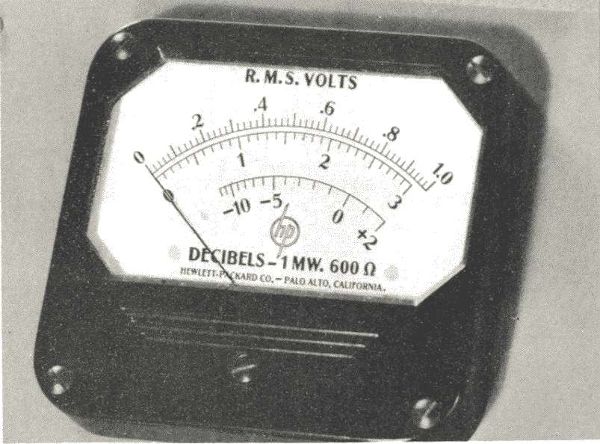
Figure 2 • Detail of Meter Face
SPECIFICATIONS
Voltage Range: A switch on the front panel selects nine voltage ranges having full scale sensitivities of 0.03 volts, 0.1 volts, 0.3 volts, 1.0 volts, 3.0 volts, 10.0 volts, 30.0 volts, 100 volts, 300 volts.
Calibration: The meter is calibrated to read the rms value of a sinusoidal wave. The voltage scale is linear and a decibel calibration based on 1 milliwatt in 600 ohms is provided. The indication is in proportion to the average value of the full wave; thus waveform errors and turnover are minimized.
Frequency Range: The frequency range is 10 cps to 1 mc.
Accuracy: The over-all accuracy of the meter is within ±3% below 100 kc and ±5% from 100 kc to 1 mc. Line voltage variations from 105 volts to 125 volts or changing tubes will affect the reading by less than 3% at all frequencies below 100 kc.
Input Impedance: The input impedance is equivalent to 1 megohm shunted by 16 uufd on the 30 volt range and below. On the 100 volt range: 3 megohms, and on the 300 volt range: 2.4 megohms.
Overvoltage Capacity: Occasional overloads of 100 times normal will not damage the meter movement. Continuous or frequent overloads should be avoided.
Power Supply: The instrument operates from 115 volts, 50/60 cycles, 40 watts.
Mounting: The meter is mounted in a steel cabinet finished in wrinkle gray. The front panel is finished in a satin gray baked enamel, with photo-etched designations. The cabinet is 7½ inches wide, 8 inches high, and 9 inches deep. A leather handle is provided at the top of the cabinet.
Net Weight: 15 pounds. Shipping Weight: 20 pounds.
Pius Steiner, 18.Sep.12
